Climate change is causing layers of snow and ice on the slopes of Mount Everest to melt, and as parts of its white cloak are shed, the bodies of hundreds of climbers who met their tragic fate while attempting to reach the world's summit are being exposed among its rocks. Among those who climbed the highest peak in the Himalayan range this year was a team whose goal was not to reach the 8,849-meter summit, but to search for forgotten bodies. Despite risking the lives of its members, the group succeeded in retrieving five frozen bodies, including a skeleton, which were transported back to the Nepalese capital, Kathmandu. Two bodies have been identified, awaiting the results of "detailed tests" to confirm their identities, according to Rakesh Gurung from the Nepalese Ministry of Tourism. It is likely that the bodies whose owners will not be identified will be cremated.
**A Difficult and Dangerous Mission**
This Nepali campaign aims to clean Mount Everest and the surrounding peaks of Lhotse and Nuptse in a difficult and hazardous mission. Speaking to Agence France-Presse, Aditya Karki, an official in the Nepali army leading a team of 12 soldiers and 18 climbers, said, "Due to the effects of global warming, the bodies and waste are increasingly visible as the snow cover shrinks." More than 300 people have died on the mountain since climbing expeditions began in the 1920s, with eight fatalities in the last season alone. Many bodies remain on the mountain, some buried in snow and others falling into deep crevasses. Bodies that have not had their colorful climbing gear removed have become reference points for climbers, earning nicknames such as "green shoe" or "sleeping beauty."
**The "Death Zone"**
Aditya Karki stated, "There is a psychological impact; people believe they are entering a wonderful land when they climb mountains, but if they encounter bodies along their path, it may negatively affect them." Many bodies have been discovered in the "death zone," where the decreased oxygen levels increase the risk of acute mountain sickness (or altitude sickness), which can become fatal after a certain period. It took 11 hours to retrieve a body that was buried in ice up to the chest, using hot water and an ice axe in the process. Chering Jangbu Sherpa, who led the recovery mission, said, "It's very difficult; removing the body is one task, and lowering it is another," noting that some bodies remained just as they were at the time of their owners' deaths, fully clothed with straps and belts.
**Mountains Turning into Graves**
Recovering bodies from the high elevations remains a controversial topic among mountaineers; it is an endeavor that costs thousands of dollars and requires up to eight rescue personnel for each body. Carrying heavy loads at high altitudes is challenging, as the weight of a body can exceed 100 kilograms; nevertheless, Karki believes this effort is necessary. He expressed, "We need to retrieve as many bodies as possible. If we leave them behind, our mountains will turn into cemeteries." During missions, bodies are often wrapped in a bag and then lowered using a sled. A body was found near the summit of Lhotse, the fourth highest peak in the world at 8,516 meters, and lowering it was one of the most difficult tasks, according to Chering Jangbu Sherpa. He mentioned, "The body was frozen, and the arms and legs were spread wide," adding that "we had to carry it as it was to Camp 3, where we managed to transport it on a sled."
**Tents, Equipment, and Gas Canisters**
The Himalayas conceal many secrets; in 1999, the body of George Mallory, a British mountaineer who disappeared in 1924, was found, but the body of his companion Andrew Irvine has never been discovered. Only their personal camera could provide evidence of their successful climbing expedition, which might rewrite the history of mountaineering. The clean-up campaign, with a budget exceeding $600,000, involved 171 Nepali guides who removed 11 tons of waste. On the path to the summit, colored tents, discarded climbing gear, empty gas canisters, and even human feces were found. Chering Jangbu Sherpa noted, "The mountains have given us many opportunities, and we must reward them by removing waste and bodies." Currently, expeditions are required to dispose of their waste. Karki remarked, "Climbers must take back their waste this year. But who will remove the old waste?"




